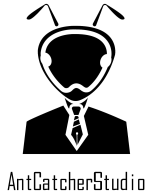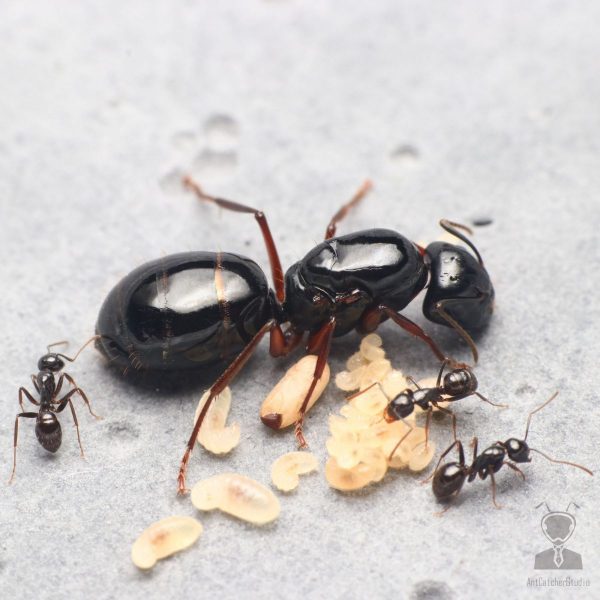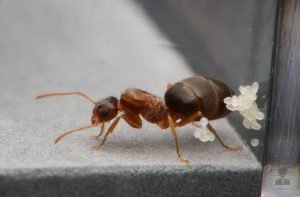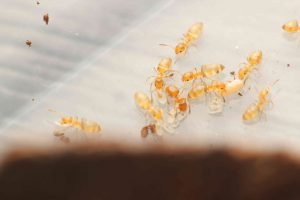
文章目錄
簡介
大黑巨山蟻是一種常見的螞蟻,蟻后體型大;工蟻體型小,成長速度快,全身為鋼琴烤漆黑色,容易飼養。
大黑巨山蟻學名:Camponotus friedae |
|||
|---|---|---|---|
|
大黑巨山蟻的體色為黑色,在光源照射下可些微反光,類似鋼琴烤漆的質感,具大型工蟻階級,使用大顎和蟻酸做為主要武器,在巨山蟻中屬中型蟻。
大黑巨山蟻為單蟻后制的螞蟻,成熟群落由1隻蟻后及約3000~8000隻的職蟻組成。大黑巨山蟻屬雜食偏速食性的螞蟻,在野外以植物花蜜、蜜腺分泌或小型昆蟲為食,廣泛分布於全台,土棲型螞蟻,築巢於土表下、石縫下等,在野外較不易發現其蹤跡,且平均工蟻體型隨群落發展年齡逐漸增加,野外的大黑巨山蟻工蟻體型明顯大於飼養的大黑巨山蟻。
飼養難度偏易,以飼料為主食,使用石膏蟻巢飼養,喜好較高濕度的環境。大黑巨山蟻有個較特殊的策略,以幫助其快速建立群落:大黑巨山蟻的蟻后在巢穴建立之初,會用盡一切資源的大量產卵,一次約10顆卵之多,並且這些首批工蟻發育速度極快,通常不到一個月即可發育成工蟻並開始工作,大黑巨山蟻正式使用此方式來快速建立群落並讓其步上軌道,但相對的,這些首批工蟻的體型明顯較小、壽命明顯較短(約2~5個月),大黑巨山蟻是所有巨山蟻裡面從產卵到出工最快速的螞蟻。
|
|||
飼養資訊 |
|||
飼養容易度 |
容易 | ||
溫濕度控制 |
不超過32度;濕度較高 | ||
生產速度 |
快 |
個性 |
敏感躁動 |
生物學資訊 |
|||
制度 |
單后制 |
食性 |
雜食偏素食性 |
巢型 |
土棲 |
特有種 |
否 |
體長 |
蟻后 |
約14〜16mm | |
兵蟻 |
約8〜13mm | ||
工蟻 |
約4〜6mm | ||
購買連結
清晰照片

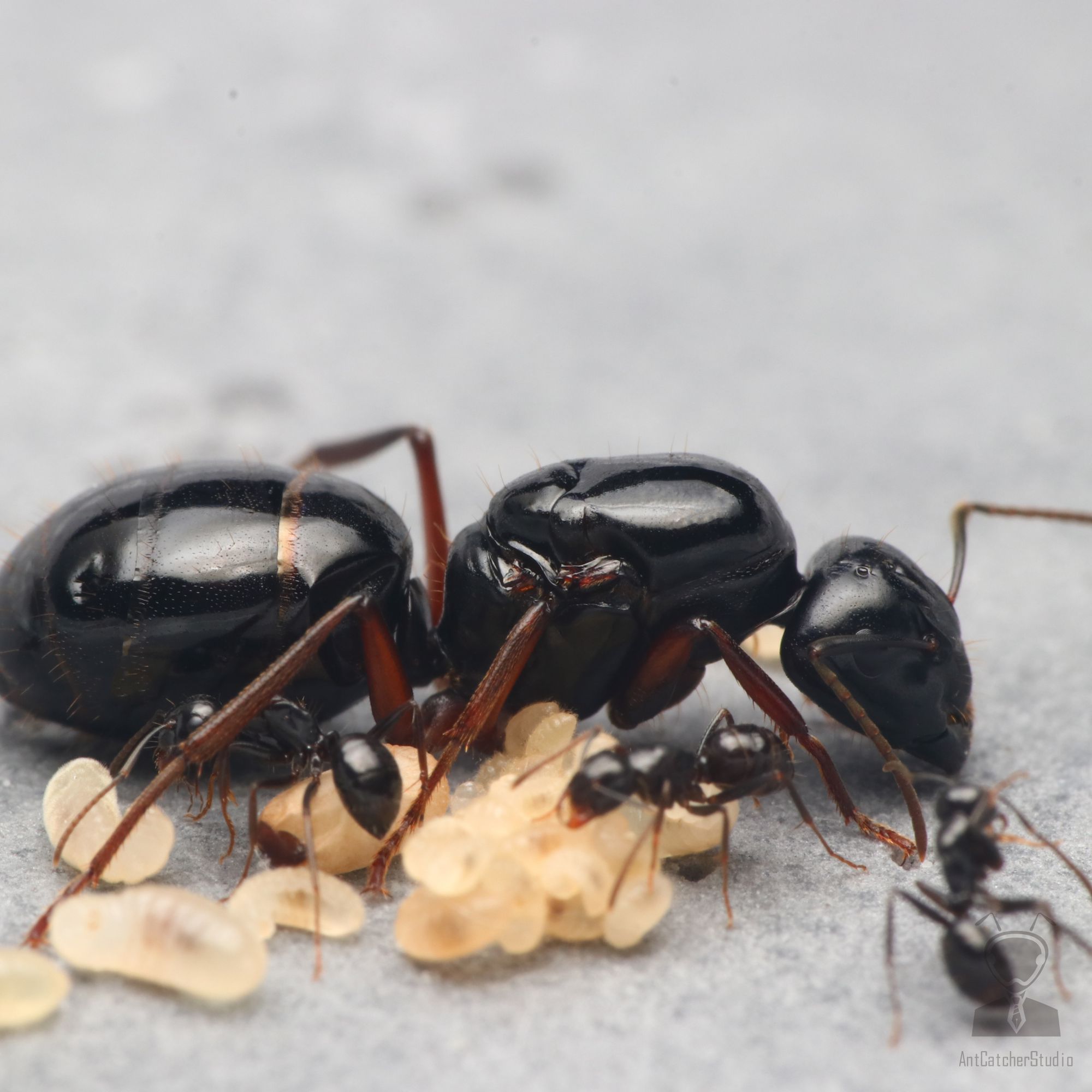
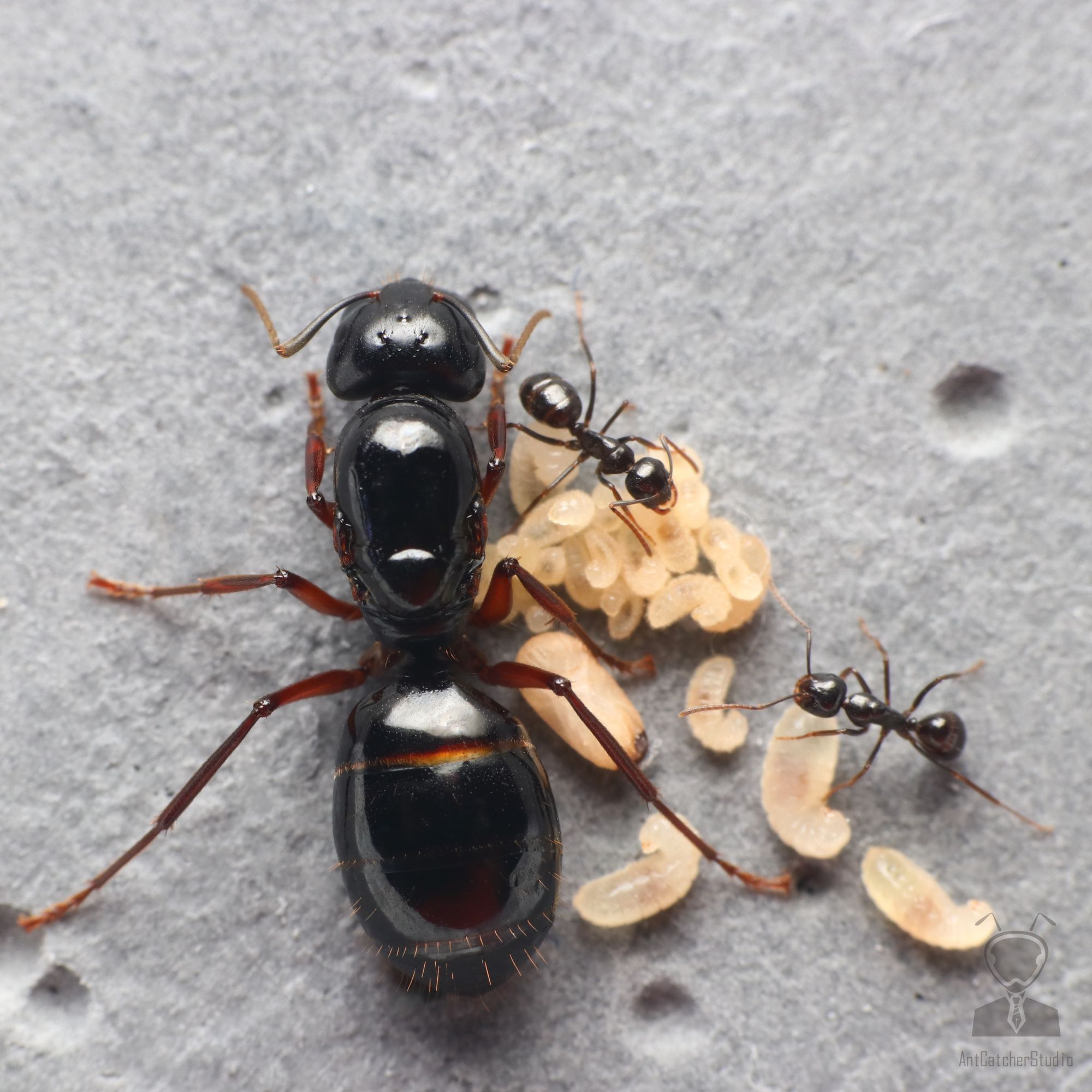


-
熱門螞蟻婚飛時刻表 | 時間 | 地點 | 自己抓蟻后
此表內容依據個人實際經驗,與蟻友分享資訊所整合,僅供參考,亦非常歡迎您與我們分享你遇到的婚飛狀況 ( 留言 /…
-
黃迷最詳細介紹 : 從入門到養殖戶 | 基本資料 | 營養成分
文章目錄1 懶人包2 黃迷的名字3 黃迷的資訊 | 成長周期3.1 卵3.2 幼蟲3.3 蛹3.4 成蟲4 黃…
-
螞蟻腸道中的隱形英雄:布氏菌 Blochmannia
文章目錄1 懶人包2 歷史邂逅:來自遠古的合作3 腸道工廠:為蟻群提供營養和健康4 蟻群健康的關鍵:交哺5 氣…
【都長那麼像,到底要如何分辨呢?】 希氏巨山蟻 VS 大黑巨山蟻
詳細說明大黑與希氏分辨方法。
詳細飼養方式
如何飼養大黑巨山蟻?以飼料為主食,使用石膏蟻巢、加氣磚、試管飼養。於室溫環境下給予水塔即可,非常容易飼養。這個章節將會說明大黑巨山蟻,在新后到成熟群落的各階段,該如何飼養,以及該注意的地方。
花費時間 至少 365 days
新后,尚未有工蟻
使用堵水試管培養,溫度維持25~30度,放置黑暗環境,靜待約一個月,蟻後會開始產卵並孵育。期間不餵食也可成功出工,但建議維持每週餵一次的頻率,如此一來,卵、幼蟲、繭的數量會明顯增加,並且可幫助虛弱蟻后補充能量。
新后,出1~20隻工蟻
首批工蟻出生後,開始增加餵食頻率,依照群落發展狀況調整,從1週1次~1週3次皆可,儘量不要讓蟻后產卵頻率中斷,餵食份量適量,切勿給太多,以免食物發臭,此階段不建議餵食活體。
小群落,20~100隻工蟻
隨著人口增加,試管空間逐漸不足,此階段可提供石膏蟻巢、加氣磚蟻巢、或是新增1根堵水試管供群落居住,搬家過程務必使用引導方式,不可暴力倒出,以免蟻群受驚嚇,導致蟻后停產。依照取食狀況調整餵食頻率,從1週1次~1週3次,可開始給予活體食物(非必要),活體務必燙熟或是弄殘,螞蟻有將食物搬回巢穴的習慣,因此活體建議越少越好,以免螞蟻吃不完,導致蟻巢嚴重發霉。
中小群落,100~1000隻工蟻
視狀況為群落提供更大的蟻巢,人口增加,蟻群食量也增加,因此也要增加餵食頻率,依照取食狀況,一週餵食2次~4次。
成熟群落,1000隻工蟻以上
大黑巨山蟻成熟群落,工蟻數量上限約在5000~8000隻左右,此階段將開始產出雄蟻、處女蟻后等階級,依照取食狀況,每週餵食5~7次。
常見疑問
大黑容易溺死嗎?
大黑巨山蟻非常容易溺斃,目前尚不清楚緣由,建議餵食時提供少量飼料,或是提供立足點。
大黑巨山蟻去哪裡抓?
全台均有分布,倖存者偏差顯示臨海地區較多,淡水首選。
大黑巨山蟻婚飛時間?
每年5~7月是婚飛季,傍晚5~7點可在郊區、山區草皮上發現蟻后(有機率)。
其他山蟻亞科蟻種
台北巨山蟻 Camponotus Formosensis
台北巨山蟻是全台灣最大的螞蟻,...閱讀更多
高雄巨山蟻 Camponotus irritans
生產速度快、食性廣,較淺的體色...閱讀更多
尼蘭德山蟻 Nylanderia sp.2
你覺得這篇文章如何? 點擊評分...閱讀更多
阿祿斜山蟻 Plagiolepis alluaudi
你覺得這篇文章如何? 點擊評分...閱讀更多
本站竭盡所能檢驗資料正確性,但仍可能有部分內容錯誤或未及時更新,還請您海涵,也歡迎來信指正錯誤之處。
本公司具有本站所有原創文字、原創圖片之完全版權及著作權,本站原創內容採 CC BY-NC-ND 3.0 ( 姓名標示 – 非商業性 – 禁止改作 )方式授權您使用,但尤其嚴禁轉載、編輯至百科類網站 (包括但不限於維基百科 ) 。
針對侵權行為本公司將直接對行為人要求索賠。第三方單獨授權本站使用之文字、圖片,本公司亦有維護原作者權益的責任。
本站除原創內容外還有部分內容來自開放版權內容和對已公開發表的文獻的利用與整理,所引用之相關圖片、文字將會進行標註說明。
